Speaker
Description
In the frame of the ATD3 working group, coordinated by ESA and CNES, a test case was proposed, representative of the interaction between two fragments generated by the break-up of a space vehicle during the re-entry.
The test was performed experimentally at the VKI Institute, and is described in detail in [1]. A ring is initially suspended over a cylinder (Figure 1), and when the flow enters the test chamber the wires are cut and the ring follows a trajectory over the cylinder, interacting with the shock wave generated by the cylinder itself.
Through the trajectory analysis, the aerodynamic coefficients for a number of different positions of the ring were calculated and are provided in [1]. One of the goals of the numerical test case is to simulate the ring in different positions and to compare the computed coefficients with the ones reconstructed from the experiment. An additional goal is to numerically compute the ring trajectory, by using the calculated aerodynamic coefficients.
In the present paper the focus will be on the first goal. All the conditions provided in [1] will be simulated, and the coefficients will be determined and compared with the experimental ones. If possible, the trajectory will be also calculated in a successive phase.
All the simulations are being performed with the NExT code, developed at CIRA. It is a multiblock structured code, able to simulate hypersonic flows including chemical and thermal nonequilibrium.
Since the code uses structured grids, a particular effort has been made in generating a topology that allows to deform the grid without changing the cells number and distribution for each block. Two strategies have been followed, by using on one side the grid generator ZENGRID, available at CIRA, and on the other side the commercial grid generator ICEMCFD: a sketch of the two approached strategies is reported in Figure 2. When ZENGRID is used, some of the features of the mesh may be parameterized to accommodate for several ring positions with respect to the cylinder and the computational grid can be then automatically generated providing in input the ring position and angle. In case of ICEMCFD, each grid is usually generated “manually” by the user, trying to optimize it for the specific ring position, even though a sort of automatization may be reached also in this case by using the ICEMCFD scripting language.
In Figure 3, a preliminary comparison is shown between the experimental values and the numerical results obtained by using the ZENGRID grid and the ICEMCFD grid. In figures 4 and 5 the Mach number contours for all the positions are shown for both the topology, even though with the ICEMCFD grid only a subset of the positions have been analyzed: in the final paper the full test matrix will be presented.
[1] D.G. Kovacs, G. Grossir, O. Chazot, “Hypersonic Aerodynamics of a Free-Flying Ring Interfering with a Two-Dimensional Curved Shock Wave—An Experimental Test Case” 2nd International Conference on Flight Vehicles, Aerothermodynamics and Re-entry Missions & Engineering (FAR) 19-23 June 2022.

